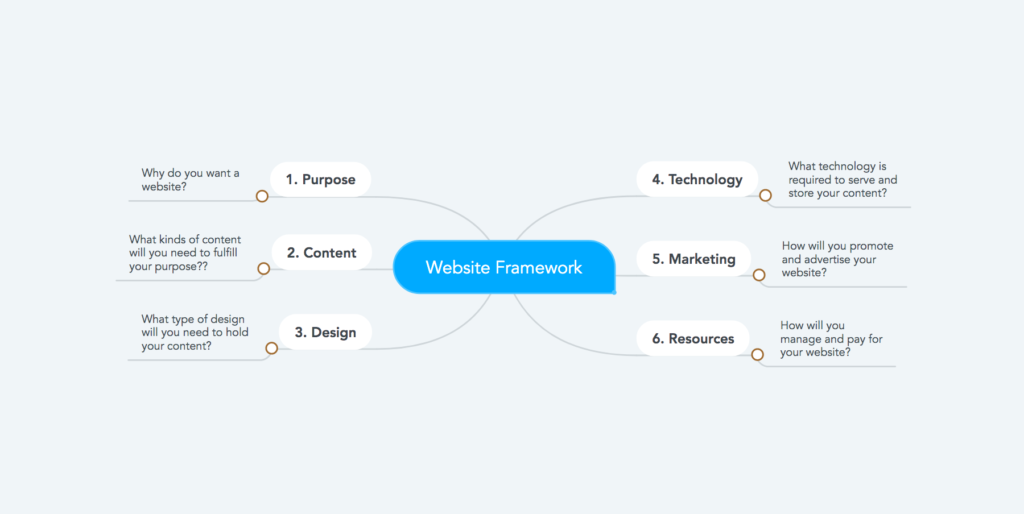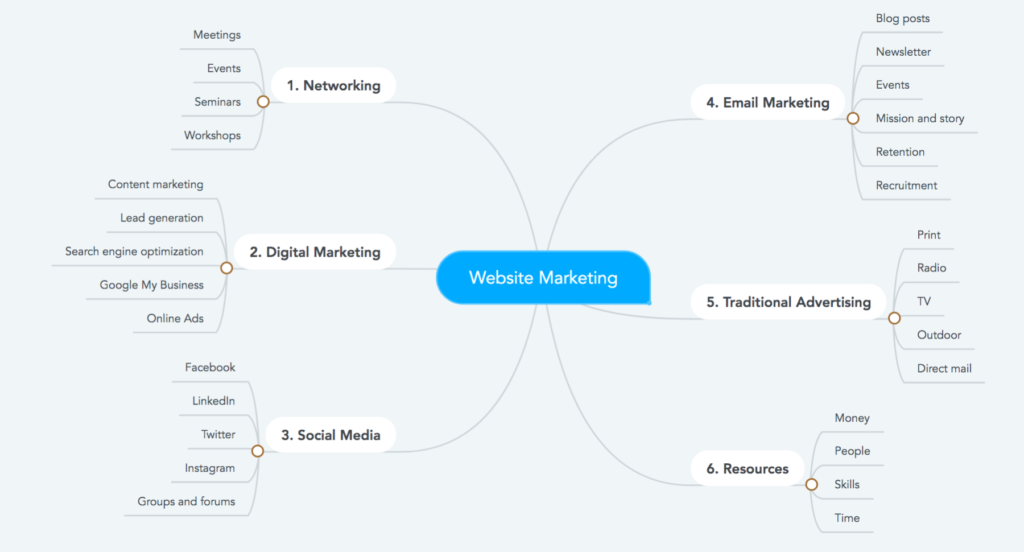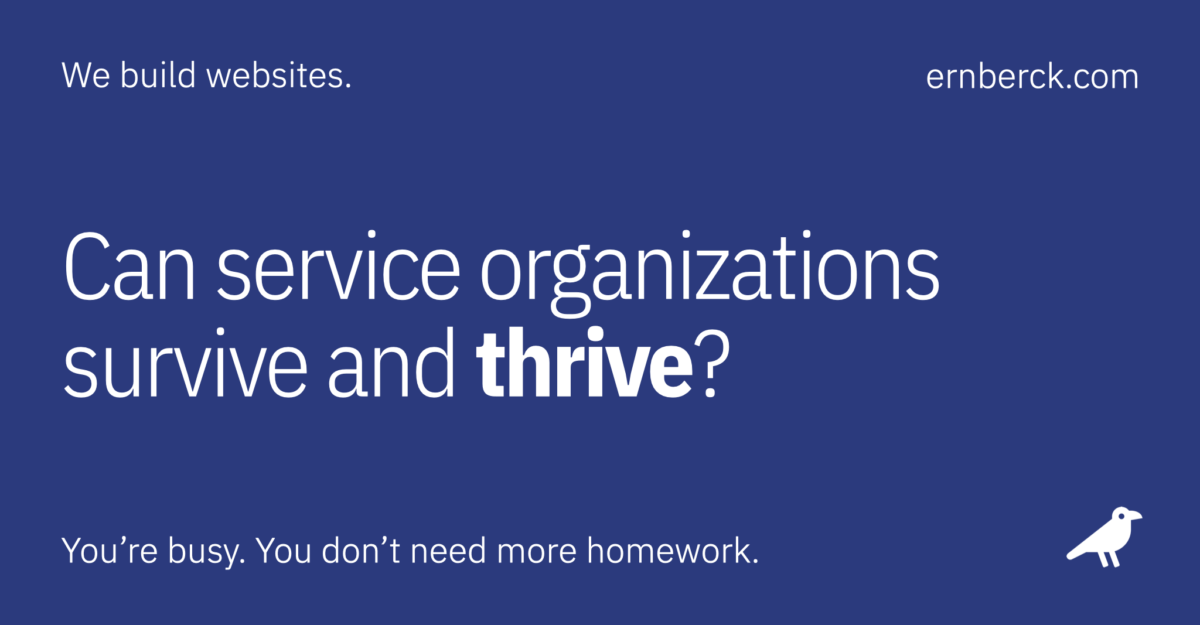Here we present a simple online framework for service organizations that will help increase awareness, create interest, and provide a clear and easy-to-use path for supporters to connect and learn.
Preserving tradition in a digital world
Despite all the changes to the media landscape in the last 20 years, the fundamentals of marketing haven’t changed much. You still need to get people’s attention, and hold it long enough to make a positive impression that leads to interaction. It’s still about creating opportunities to start a conversation. And it’s still not easy.
Service organizations — once the backbone of community life in America — face the additional challenge of a rapidly changing America. New attitudes, lifestyles, expectations, goals and rituals — All threaten to erode club traditions, membership, and community influence. Can effective marketing help turn this trend around?
A marketing blueprint for civic organizations
Volunteer civic organizations have been in significant decline over the past three decades. It’s not so much that the clubs have changed, but that America has changed. It’s imperative for service organizations to reinvent themselves for a new “digital” America.
The purpose of this article is to outline a simple digital framework — using websites, social media, and email — that you can use to increase awareness, generate interest, and provide a clear and easy-to-use path for supporters to connect and learn.
The fundamental marketing principles presented here can apply to any organization, nonprofit or otherwise, that seeks to improve their membership using digital channels.
Some membership organization topics to consider:
- Is the issue member recruitment or retention
- Set higher expectations for members
- Is the weekly lunch format outdated
- Create a less formal atmosphere
- Enable members to involve their families
- Offer more family-friendly events and environments
- Review arcane rituals and meeting formats
- Emerging generations want to have an impact now
- Emerging generations now define community by their affinities
- Poor use of marketing technologies
- Outdated club management platforms with poor user experience
- Outdated leadership policies
Using digital channels to drive website traffic
There are dozens of digital marketing channels available to reach your audience, but none are more powerful — or give you more control — than your own business website. Whether it’s products, services, news, membership, politics, or education, if you’re conducting any type of sales today, your website is the zero moment of truth. That’s where it all starts.
The sole purpose of every marketing endeavor — paid advertising, social media, email marketing, whatever — is to drive people to your website and encourage them to interact with you. So, the first thing you need to get right is your organization’s primary website. There’s no sense in pushing potential members to an obsolete and irrelevant location that has no clear purpose or call to action.
A Facebook page is not a website
A Facebook business page can help an organization engage their audience, grow their membership, and provide “social proof,” but it’s no substitute for a dedicated website. Remember:
- A Facebook page is a tool, not a business website.
- Facebook pages belong to Facebook, and they make the rules.
- Your website belongs to you.
- Facebook owns your audience, you don’t.
- Facebook is temporary, websites are permanent.
Learn more: A Facebook page is not a website
Six elements of an effective website
Website development has been called “the most hostile engineering environment imaginable.” That sounds scary, but it’s accurate. Websites are complicated — they have lots of moving parts. To build an effective online presence, you first need to recognize and define six elements of a website framework that work together to meet your business goals.
These six elements will:
- Establish your position in the marketplace
- Help you find and engage qualified customers
- Make it easier for customers to do business with you
Note: If you already have a website — or are subject to certain organizational constraints or commitments — carefully review your site’s content and functionality to see what can be improved.
01. Purpose
Why do you want a website?
Most organizations assume that they need a website because everybody else has one. That may be true, but if you want a successful online presence you really need to focus on your audience and business goals.
- What do you want it to do?
- How do you expect it to work?
- What are your business goals?
- How will your website help achieve these goals?
- Who are your members?
- Why would new members want to join your organization?
02. Content
What kinds of content will you need to fulfill your purpose?
Explain your business and services in easy-to-understand terms. This sounds much simpler than it really is. Not only does your copy need to be unique, relevant, and authoritative — Google has to like it.
- What kind of content will you need to meet your business goals?
- Do you need a blog or news section?
- What type of media will you be hosting: Text, images, audio, video, documents?
03. Design
What type of design will you need to hold your content?
The web is made of content, and design is what holds all that content in place. You not only want your website to look nice, you want it to be useful, usable, and easy to navigate.
- How will it be organized?
- What colors and typography would be most effective?
- How will visitors be able to interact with it?
04. Technology
What technology is required to serve and store your website content?
A stunning design full of wonderful content won’t do you much good unless you have a way to deliver it quickly, reliably, and securely.
- Where are your members?
- Are they local or global?
- What privacy laws do you need to comply with?
- Who will manage your website?
- What kind of access will they need?
- What maintenance tasks will they need to perform on a regular basis?
05. Marketing
How will you promote and advertise your website?
Okay. You built the perfect service organization website and filled it with original and authoritative content. Unfortunately, nobody knows about it. Nobody can find it. Nobody cares. Now what?
This is where marketing comes in. You’ll also need some sort of lead generation plan, an active social media presence, and some solid search engine optimization (SEO).
06. Resources
How will you manage and pay for your website?
You’ll never accomplish tasks 1–5 unless you’ve got the people, time, skills and money. If you build a website you can’t manage or promote, you haven’t solved a problem — You’ve created one. Launching a website isn’t the end of this process, it’s just the beginning.

How to promote your website
Does your website generate interest in your organization And if it does, how do you know? Whether you promote products, services, or memberships — online or off — your website is probably a prospect’s first interaction with your business. This means making sure that your website is relevant to your target audience, and that it’s highly visible in your market.
Unfortunately, the “If you build it, they will come” theory no longer applies in the modern business world — Least of all online. It’s no longer possible to build a website that magically attracts profitable customers (or worthwhile members).
As mentioned above, the primary purpose of your marketing strategy should be to drive people to your website and encourage them to interact with you. But before you invest in a multi-channel marketing plan, let’s explore your options first and figure out what’s best for your organization.
Learn more: How to promote your website
01. Networking
The dynamics of this ancient channel haven’t changed much. Networking is directly interacting with other people to exchange information and develop contacts — especially to achieve a certain business goal.
A few opportunities for personal networking include:
- Meetings
- Events
- Seminars
- Workshops
02. Digital marketing
In simple terms, digital marketing (sometimes called online marketing) refers to advertising delivered through internet based channels such as websites, social media, forums, search engines, email, and mobile applications.
Some online marketing strategies might include:
- Content marketing
- Lead generation
- Search engine optimization (SEO)
- Google Business Profile (formerly Google My Business) (local search)
- Online ads
03. Social media
Despite any personal feelings you may have, when it comes to marketing you have to use what’s available. And social media can be a highly effective marketing channel for nonprofit organizations. Not only can it be free, but it provides an avenue for groups to show their personalities and engage with their followers and supporters.
Popular social media channels worth exploring:
- Groups and forums
The power of engagement
When it comes to the impact your social media marketing will have, I can’t overstate the importance of engagement. That means your posts must generate likes, shares, comments, and replies — Anything that indicates interest and interaction with followers. Just randomly posting items in your club’s Facebook feed isn’t enough. Your entire membership needs to get involved and actively participate in the online conversation.
Learn more: The truth about social media engagement
04. Email marketing
Email marketing is the act of sending a commercial message, typically to a large group of people, using email. In its broadest sense, every email sent to a potential or current customer could be considered email marketing.
And despite all the hype about TikTok, Facebook ads and YouTube videos, there’s still no better way to connect with your members and grow your organization than through email. Yet the vast majority of businesses aren’t using it effectively.
You might be using email sporadically to call for members or solicit support, but that’s not enough. Email marketing can be a very effective marketing tool, especially for nonprofit organizations. Why? Because when done properly, it’s personal, powerful, and can be highly automated.
Email is the most effective way to share organization news, including:
- Blog posts
- Newsletter
- Events
- Mission and story
- Retention
- Recruitment
Own your audience
On any other platform, whether it’s Instagram, YouTube, Facebook, or even Google search results, you don’t own your audience — they do. They control who sees your content and who doesn’t. And, when they decide to change their policies, strategies or algorithms, you could be toast.
With email, you own your list. When someone signs up and willingly gives you their email address, you get to keep it. You can contact customers and prospects directly using personal information they freely gave to you.
Plus, if you ever decide you don’t like your email marketing software, you can just download your list and move to a different platform. Your audience goes with you.
Learn more: What is email marketing
05. Traditional advertising
This is good old-fashioned “outbound” marketing: Newspaper, radio, magazines, billboards, TV, banner ads. The downside, of course, is that you have to pay for it. And it can get painfully expensive in a hurry. Depending on the media, reach, and frequency, it can end up costing you a large chunk of change.
Contrary to popular belief, traditional advertising isn’t dead, it’s just been sleeping. With all the new privacy laws ond online tracking restrictions, I think traditional advertising may be poised for a comeback.
There will always be a need for old-fashioned interruption marketing tactics:
- Radio
- TV
- Outdoor
- Direct mail
06. Adequate resources
If you build a digital marketing system that you can’t sustain, you haven’t solved a problem; you’ve created one. So, before you tackle website management and social media, you need to have a clear picture of what long-term resources are available to achieve your marketing goals.
Necessary resources typically includes:
- Money
- People
- Skills
- Time

Your organization needs a strategy
If you really want to leverage all the web has to offer, you need to connect these six elements together to form a lead-generating business tool — Not just a website, but a marketing machine.
To accomplish that you need a carefully considered online marketing strategy that will inform how all of these elements should be integrated to best suit your business goals.
If you don’t currently have a marketing strategy — or the confidence to create one — a talented web designer can help you. The best designers can even point out flaws in your thinking, and help prevent expensive marketing mistakes.
An effective online marketing strategy starts with a couple simple steps:
01. Set your goals
Ultimately, this is what you want to accomplish:
- Build and maintain a better organization website that’s current, relevant, easy to find, and easy to use.
- Use social media, email, and other marketing channels to drive potential members to your website.
- Use lead generation tools on your website (forms, newsletter, calendar, blog, etc) to begin an exchange of information that builds trust, awareness, and engagement.
- Nurture these leads into relationships that can lead to long-term membership.
- Take care of your members.
02. Follow an action plan
To get your marketing program started, try to accomplish the following 10 tasks as soon as possible:
- Make a list of all online assets (websites, social media accounts, email accounts, applications, online storage, etc).
- Collect and verify all login credentials for all online assets.
- Appoint a website manager.
- Appoint a social media manager.
- Define a marketing budget.
- Define your marketing goals (retention and recruitment).
- Define your ideal member.
- Review and improve your website.
- Review and open social media accounts.
- Explain importance of social media engagement to membership.
Postscript
Marketing can be an effective tool to help slow the decline of community service organizations. It can help raise awareness about the organization and the positive impact it has on the community. By effectively communicating the value and benefits of the organization, marketing can help attract new members and volunteers, and retain current ones.
However, it’s important to note that marketing alone may not be enough to slow the decline of community service organizations. Such a challenge often requires a multifaceted approach, including addressing underlying issues such as apathy, lack of engagement, lack of relevance to younger generations, and few resources.
Related
- 33 signs that you might need a better web designer
- Six elements for online success
- Outbound marketing lives
- Websites that work
- What is email marketing
Revised: Monday May 22, 2023 at 9:47:20 AM PDT
